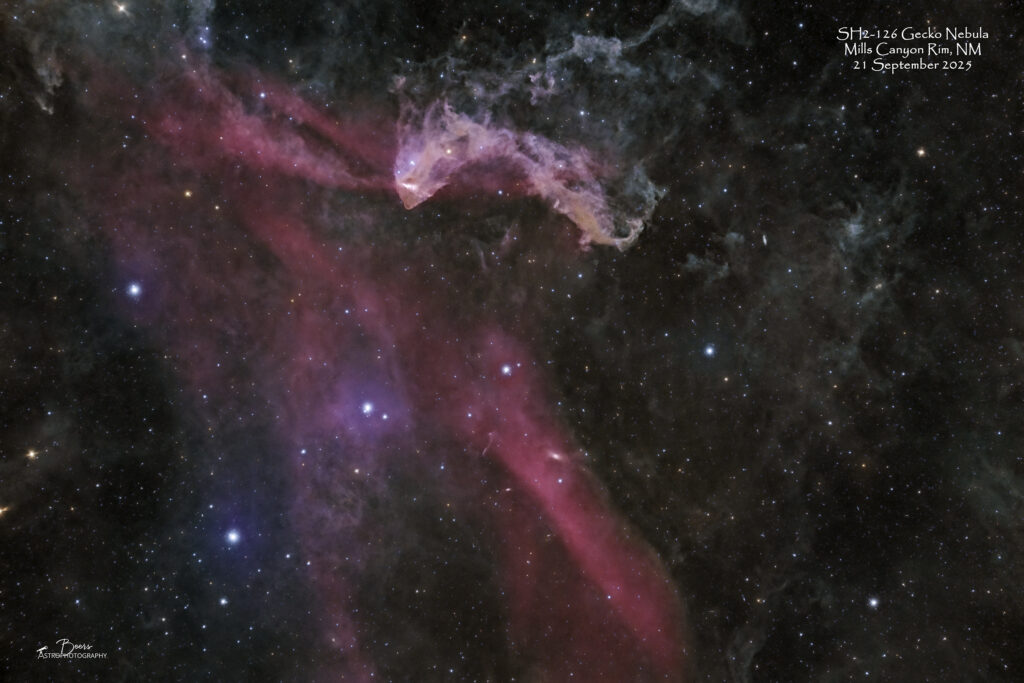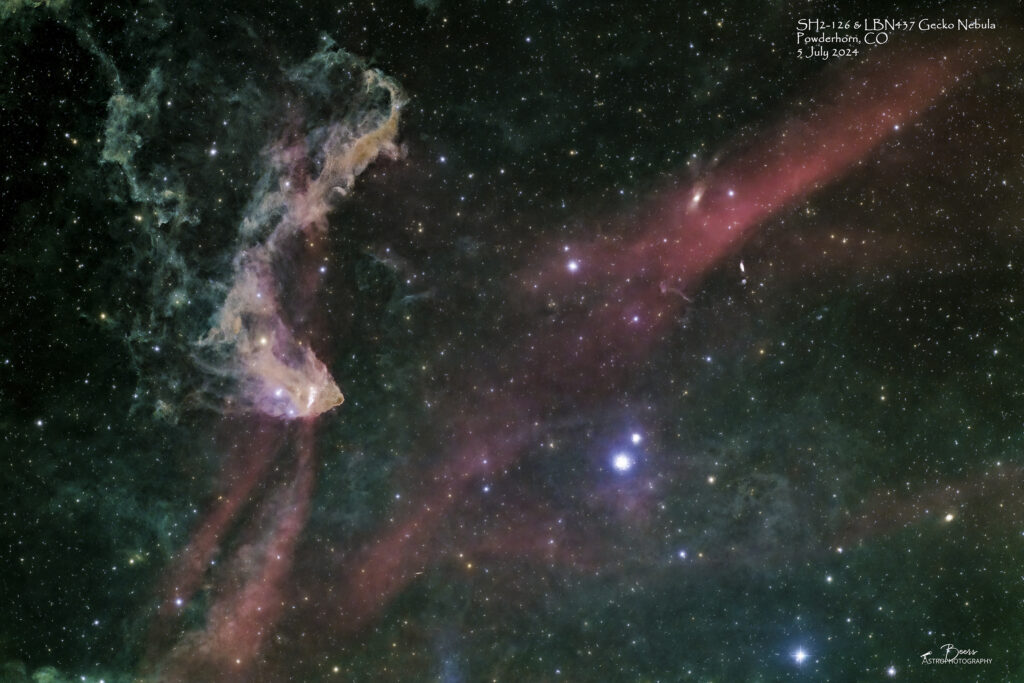
Target Fun Facts
LBN437 & SH2-126: SH2-126 is a large emission nebula in the Lacerta (The Lizard) constellation. It appears in this image as the red nebula. The source of its ionization is the intense ultraviolet radiation from the star 10 Lacertae, a blue main sequence star.
The yellow-brownish nebula, which forms a “stellar funnel” is designated LBN 437, also known as The Gecko Nebula. It is a molecular cloud whose densest part is associated with some bright young stars. Its most striking feature is a symmetrical reflection nebula associated with the Herbig Ae/Be star V375 Lacertae. This star is also responsible for the bipolar Herbig-Haro objects within the nebula. Herbig-Haro objects are small nebulae around young stars. They form when gas ejected by the star hits dust clouds.
This region, with its faint nebular filaments, is part of Lacerta OB1, a giant star-forming region about 1200 light-years from Earth. {From: https://stargazerslounge.com/topic/401393-sh2-126-and-lbn-437-the-gecko-nebula-in-halrgb-2-pane-mosaic/}
Other Catalog Designations: LBN437 Gecko Nebula
Subtype: Nebula
Distance from Earth: 1200 light years
Apparent Size: 1°15’ x 20’
Constellation: Lacerta
{Target information derived from Stellarium }
Other Catalog Designations: SH2-126, LBN428
Subtype: HIII region
Distance from Earth: 1200 light years
Apparent Size: 1°50’ x 30’
Constellation: Lacerta
{Target information derived from: Stellarium }
Capture & Processing Notes
This image was captured during our September 2025 dark skies trip to Mills Canyon Rim, Kiowa National Grasslands, New Mexico. After I got Big Bertha up and running on capturing NGC7380 Wizard Nebula, I turned my attention (and my stool even deeper into the mosquito swarm – see the blog for the rest of that story) to the Southern Cross and SH2-126 Gecko Nebula.
After I got the polar alignment done and the cabling connected, at 21:27 I began the sequence. I slewed to the target area and aborted the focusing routine (which was NOT going to resolve when the telescope was nowhere near in focus). I reset the focuser to zero, then progressed it outward by steps of 1000. When I got to 7000 I achieved a good focusing result of: 848 stars, HFR 1.21 (with the focuser at about 2cm). I checked the autoguider camera focus – which was good – then restarted the sequence. At sequence restart, the EAF routine started and although I thought the focus point of 7000 was very close, it was not so close that it didn’t give me a scare that things were not going to work out well! When the EAF started its routine by producing a straight line (instead of the “V”) I began having nightmare flashbacks to my 3+ hours of trying to focus the QHYCCD camera!! It did continue to move inward toward focus until it resolved at 6205 with a HFR 1.8 and a 96% curve fit match (thankfully NOT including the straight line portion!). The sequence continued with the platesolving and autoguider calibration (@21:39), then ran the EAF one more time (6205, HFR 1.9, 95% curve fit) and started the sequence at 21:44MDT. Seventeen minutes from start to first subframe is not too bad!
I came back out at midnight for the meridian flip (purely by accident, rather than intentional planning both targets’ flips were within 10 minutes of each other!) The mosquitoes had not died off or diminished in any way, so I decided at that point, even though we had planned to stay for two nights (thus I’d set up both telescopes) I could not deal with another night being a mosquito pin cushion. So, we came home on Sunday morning versus our planned Monday morning. I’d also decided that since I was planning to take Monday off because we were going to be traveling back – I was still going to take the day off, to get started on the processing and just have an AP instead of a work Monday.
When I started with the processing and produced my first stack…I realized that the flats’ exposure that I had calculated before we left on this trip was way off…the exposure length was too long, creating a calibrated result that was not at all corrected (particularly in the vignetting). So, I recaptured the calibration frames, restacked, and then went on with the processing. (The Southern Cross doesn’t seem to have the same issue with the star reduction artifacts as Big Bertha’s images do, so it was one simple (once I had the right calibration frames to work with) process to generate the image.
As I did the planning for this target, for the Southern Cross using its 0.7x reducer giving me a larger field of view, I framed it to capture more of the red nebula behind the Gecko…thinking it was the Scarlet Letter Nebula. As I was writing up my journal, I started to type “this is the Gecko Nebula on top of the Scarlet Letter Nebula” but then decided I had better check my facts (i.e., verify the RA/Dec location). The result was:
- SH2-126, LBN 428 Gecko Nebula: RA 22h 34m 39.41s; Dec 40° 40’ 10.9” (Lacerta)
- SH2-96, LBN 150 Scarlet Letter Nebula: 19h 28m 41.33s; Dec 32° 41’ 04.3” (Cygnus)
Hmmm, guess not! The Southern Cross with its 0.7x reducer’s focal length of 420mm is wider (vs. the Southern Cross’ 600mm) but it’s not THAT wide (3hours of Right Ascension (=45°) x 8° of Declination)!!
I know what you’re thinking…jeez, don’t you read your own Target Fun Facts where you describe that LBN428 is the Gecko and SH2-126 is the red nebulosity? I’d ask you to give me a little grace here…I’m operating without access to our file server (thank you Mother Nature for the lightning strike that took out our internet modem and network switch during the week before we left on the trip, which still hasn’t been fully restored!). So instead of starting the journal from my from last year’s entry on the Gecko Nebula…I was Googling information from scratch.
But I had a REALLY FUN discovery while “researching” using the authoritative Google source! I googled “catalog number for Scarlet Letter Nebula.” Google responded: SH2-96. Then I googled SH2-126. Google responded: beersastrophotography.com in the list of references and in the Google images!! The modern equivalent of seeing your name in lights!


Equipment
All equipment controlled by HP Probook (DSO-CTRL1) running Sequence Generator Pro v4.4.1.1441.
- Imaging (ASI2400-SC with 0.7x Reducer): ZWO ASI2400MC imaging camera; (Southern Cross) Askar FRA600 108mm f/5.6 Quintuplet Petzval Flat-Field Astrograph with Askar 0.7x Reducer for Askar FRA600 108mm Astrograph
- Mount: Rainbow Astro RST-135E (controlled by iHubo ASCOM driver)
- Polar alignment: QHYCCD camera (controlled by Polemaster for polar alignment)
- Autoguiding: Orion 60mm Multi-Use Guide Scope with Orion StarShoot AutoGuider Pro Mono Astrophotography Camera (controlled by PHD2)
- Auto Focuser: ZWO EAF Electronic Automatic Focuser – Standard (New 5V Version) (EAF-5V-STD)
Summary
Sequence plan: Gain 158, Offset 30, Temp 0°C; 85x5min. Captured 20Sep2025, 21:44MDT – 21Sep2025, 05:40MDT
Captured: 20 September 2025
Shooting Location: Mills Canyon Rim, Kiowa National Grasslands, New Mexico
Processing Summary: Captured in SGPro, stacked in APP, star removal with Starnet++, processed in LR/PS
Previously captured image of LBN437/SH2-126 Gecko Nebula

Equipment
All equipment controlled by HP Probook running Sequence Generator Pro v4.4.0.1339.
- Imaging (ASI2400-SC): ZWO ASI2400MC imaging camera on (Southern Cross) Askar FRA600 108mm f/5.6 Quintuplet Petzval Flat-Field Astrograph
- Autofocuser: ZWO EAF Electronic Automatic Focuser – (EAF-5V-STD)
- Mount: Rainbow Astro RST-135E (controlled by iHubo ASCOM driver)
- Polar alignment: QHYCCD camera (controlled by Polemaster for polar alignment)
- Autoguiding: Orion 60mm Multi-Use Guide Scope with Orion StarShoot AutoGuider Pro Mono Astrophotography Camera (controlled by PHD2)
Capture & Processing Notes
After I got BB started on her first image of the night, I got SC started on the Gecko Nebula – again the autofocuser performance wasn’t great…although changing from 7 to 9 data points (or maybe it was the change from 100 to 75 steps per data point) decreased the influence of the “dog ear” points at the start, it didn’t eliminate them. SGP would resolve the autofocusing but with a warning that it wasn’t optimal, so I went into the control panel and unselected “use autofocus” for the rest of the sequence (night). The target rose right at about 2200 and was scheduled for its meridian flip at 0445 – perfect timing for when astronomical twilight was ending – so SC ran all night collecting data on a single target…70x5min subframes at gain 158.
Stacked (Saturday afternoon in the Beast) SH2-126 Gecko Nebula and it looks GREAT! I am very excited to have a new object to process and add to my collection. I’m not sure where this object came from – it was in my July Telescopius list, so obviously I found it on one of the lists I combined last year to create those monthly lists – but I can’t remember its origin. Wherever it came from, I’m glad I stumbled upon it – it will make a good New Mexico, Southwest, or desert scene image.
Summary
Sequence Plan (5Jul2024): Gain: 158, Temp: -0°C, offset=30. 70x5min. Captured 5Jul2024, 2216MDT – 6Jul2024, 0437MDT. Total exposure time: 350minutes or 5:50hrs (ASI2400-SC)
Captured: 5 July 2024
Shooting Location: BLM land near Powderhorn, Colorado
Processing Summary: Captured in SGPro, stacked in APP, star removal with Starnet++, processed in LR/PS
